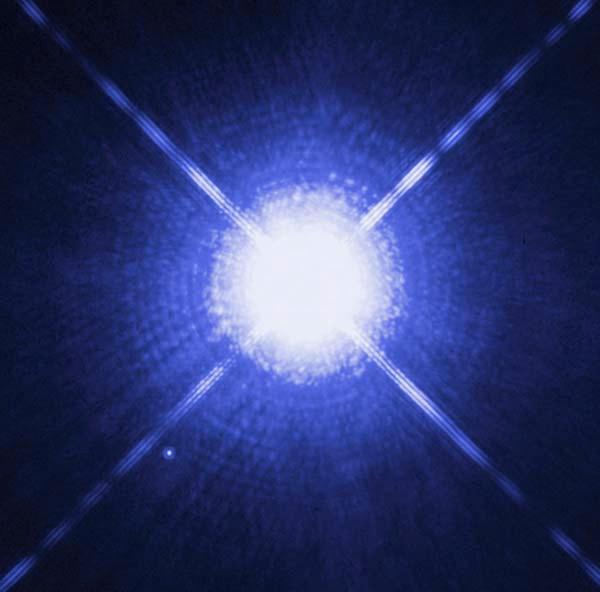[/caption]
Sirius B is the name of the fainter, smaller, less massive star in the Sirius binary system (the brighter, larger, more massive one is Sirius A, or just Sirius). It was hypothesized to exist almost eighteen years before it was actually observed!
Details: Bessel – yep, the guy who Bessel functions are named after – analyzed data on the position of Sirius (Bessel was the one who first observed stellar parallax), in particular its proper motion, and concluded – in 1844 – that there was an unseen companion star (the same principle used to infer the existence of Neptune, around the same time). In 1862 Alvan Clark saw this companion, using the 18.5″ refracting telescope he’d just built (quite a feat; Sirius B is ~10 magnitudes fainter than Sirius A, and separated by only a few arcseconds).
Sirius B is a white dwarf, one of the three “classics”, discovered to be white dwarf stars in the early years of the 20th century (Sirius B was the second to be discovered – 40 Eridani B had been found much earlier, and Procyon B was also hypothesized by Bessel (in 1844) though not observed until much later (in 1896)). It is one of the most massive white dwarfs so far discovered; its mass is the same as that of the Sun (approximately). Like all white dwarfs, it is small (it has a radius of only 0.008, compared with the Sun’s, which makes it smaller than the Earth!); like most seen so far, it is hot (approx 25,000 K).
Sirius B was likely a five sol B star as recently as 60 million years ago (when it was, coincidentally, approximately 60 million years old!), when it entered first a hydrogen shell burning, then a helium shell burning, stage, shed most of its mass (and enriching its companion with lots of ‘metals’ in the process), and shrank to become a white dwarf. There is no fusion taking place in Sirius B’s degenerate carbon/oxygen core (which makes up almost all of the star; there is a thin, non-degenerate, hydrogen atmosphere … this is what we see), so it is slowly cooling (it cools so slowly because it has such a small surface area).
Packing such a large mass into such a small volume means that Sirius B’s surface gravity is huge … so great in fact that it serves as an excellent test of one of the predictions of Einstein’s theory of General Relativity: gravitational redshift (this was first observed in the lab in 1959, by Pound and Rebka). The most recent observation of this gravitational redshift was by the Hubble, in 2005, as described in the Universe Today article Sirius’ White Dwarf Companion Weighed by Hubble.
Other Universe Today stories about Sirius B include White Dwarf Theories Get More Proof, and this 2005 What’s Up This Week one.
Astronomy Cast has two episodes related to Sirius B, Dwarf Stars, and Binary Stars.
References:
http://www.solstation.com/stars/sirius2.htm
http://en.wikipedia.org/wiki/Sirius

